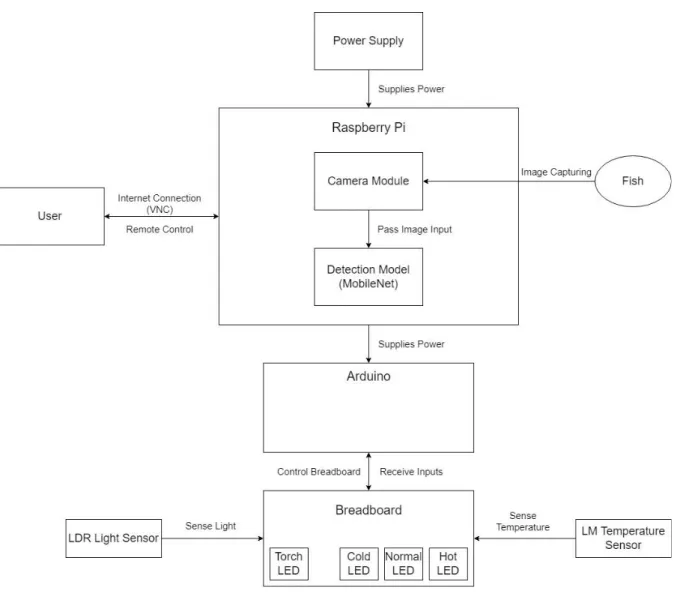In order to increase and maintain the efficiency of the fish farm, many have used different approaches to monitor the fish in the fish farm. Furthermore, with only raw human power, the effectiveness of the monitoring process could be greatly reduced.
LIST OF TABLES
LIST OF ABBREVIATIONS
Introduction
- Problem Statement and Motivation
- Objectives
- Project Scope
- Contributions
- Report Organization
In addition, it is also mentioned that one of the goals of this project is to develop a fish monitoring system that allows users to safely monitor fish without staying at the fish farm location. In short, the overall implementation of this project is to improve the efficiency and functionality of the proposed system in FYP 1.
Literature Review
Review of the Technologies .1 Laptop
- Raspberry Pi OS (Buster) 32-bit
- Microcontroller
- Programming Language
- Convolutional Neural Network (CNN)
Therefore, with sufficient research on the SBC requirements, we would use the SBC model to complete the proposed Raspberry Pi 3B+ system. Also, based on the studies on SBCs, most Raspberry Pi SBCs support many types of OS, especially for Linux OS.

Review of the Existing Systems
- Paper 1
- Paper 2
- Paper 3
Therefore, both the authors proposed their system to overcome the problem as mentioned earlier. According to Figure 2-2-1-1, this is the visual representation of the proposed system developed by both the authors for the development of the low-shot visual learning system. According to the proposed system, the performance of the proposed system still does not reach the peak accuracy result.
However, due to the design of the system framework, the proposed system is not suitable for use in a computer with low computing power. In short, the API is key in this project to speed up the processing time of the proposed system. Based on the design of the proposed system in this document, there are some points that need to be mentioned and discussed.
First and foremost, according to Figure 2-2-3-1, the overall design of the proposed system includes two individual subsystems with different purposes. The authors mentioned that the first component of the system that would start the whole process is the robot itself, which is controlled by a Raspberry Pi. In short, the weakness of the proposed system is that the system still requires a high price and a high computational power computer to operate the detection system.
![Figure 2-2-1-1 Diagram of Proposed System Source : [17]](https://thumb-ap.123doks.com/thumbv2/azpdforg/10216718.0/30.892.138.768.662.844/figure-diagram-proposed-source.webp)
System Model
- System Design Diagram
- System Architecture Diagram
As discussed in the previous chapter, the main difference between the Raspberry Pi and the Arduino is that Raspberry Pi is a microcomputer while Arduino is a microcomputer. To carry out the process, the Raspberry Pi will first capture the fish images with the camera module installed in it. Next, the Arduino will be responsible for providing the information about ambient temperature and lighting.
For that reason, the power supply could easily be solved by connecting the Arduino directly to the Raspberry Pi to act as a power supply. Therefore, remote users are allowed to access the system over a network connection through a software application known as VNC if users wish to use the system remotely. Users are also allowed to monitor ambient temperature and illuminance when using the system at the machine site and the specific details are discussed in the next section.
As mentioned earlier, users are allowed to use the system either by using it directly at the machine site or by using remote access. First, user can use any computer such as a laptop or PC and remotely access the Raspberry Pi via VNC. To do this, users must enter the credentials to log into the Raspberry Pi.
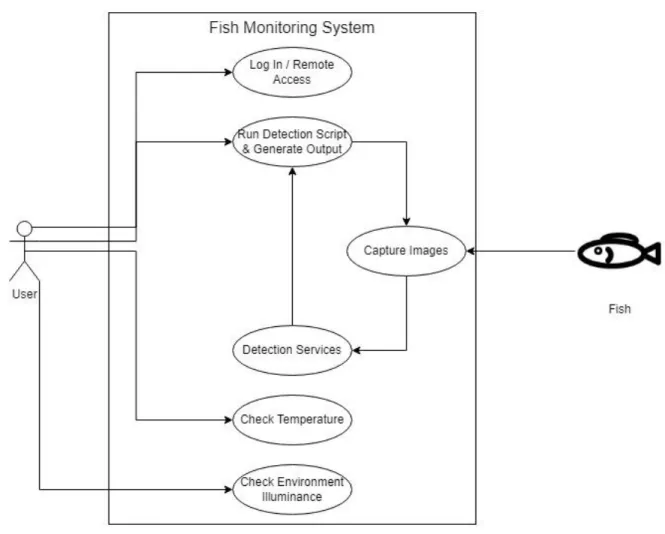
System Design
- System Block Diagram
- System Components Specifications
- Circuits and Components Design
- Software Requirement & Preparation
- Dataset
Otherwise, the green LED will be activated to indicate that the temperature of the environment is in good condition. Additionally, the specific model of the Raspberry Pi that will be used in this project is the Raspberry Pi 3 Model B+. Based on the Figure 3-1-1-1, it illustrates the overall design of the fish monitoring system architecture.
In this project, the main component to be developed is the deep learning module that is responsible for detecting the existence of the fish entity from the images. Moreover, the MobileNet model used in the previous project is also known as "SSD MobileNet V2 FPNLite 320x320". The table below shows the variety of MobileNet architectures that will be used in the performance evaluation.
In addition, the model's mAP performance is slightly lower compared to the first model, which is 19. In the experiment, all deep learning models were deployed and trained with the image dataset as described in section 4.3.2. Once the model evaluation is made, the result of the experiment is as shown in the following table.
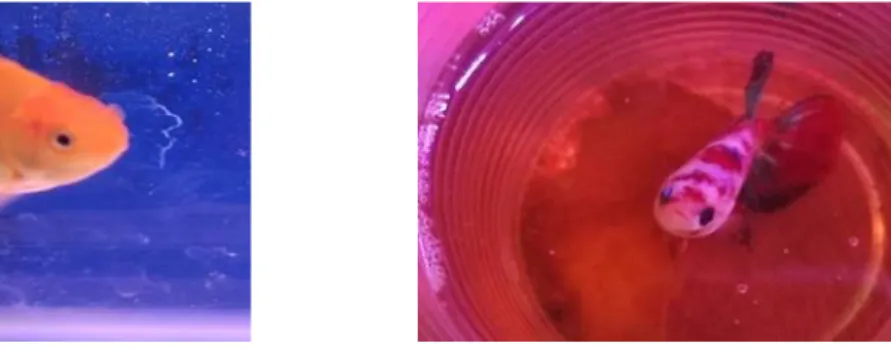
System Simulation
Hardware Setup
Diploma in Information Technology (Honours) Communications and Networking Faculty of Information and Communication Technology (Campus Campus), UTAR. Additionally, the Raspberry Pi is now powered on and connected to the router via an Ethernet cable. After this, the Raspberry Pi should now have an internet connection with an assigned IP address.
To connect the laptop to the Raspberry Pi, it is important to identify the IP address of the Raspberry Pi assigned to it because the VNC viewer connects one device to another based on the IP address of the device to be connected. To identify the IP address of the Raspberry Pi, one of the easiest ways is to log into the router and check the IP address assigned to the SBC. In addition, if the router is not accessible due to a permission issue, it is still possible to discover the IP address of the SBC using a tool available in most Linux distributions called "netdiscover".
During the setup process, a dummy Raspberry Pi OS virtual machine was made using VirtualBox to use "netdiscover" to reveal the IP address of the SBC and the sample output of the command is shown in Figure 5-2-1. Once the IP address is retrieved, the user can access the Raspberry Pi using the VNC viewer according to the IP address as mentioned earlier. Once the connection is established, the VNC viewer should produce the similar output as shown in Figure 5-2-2.
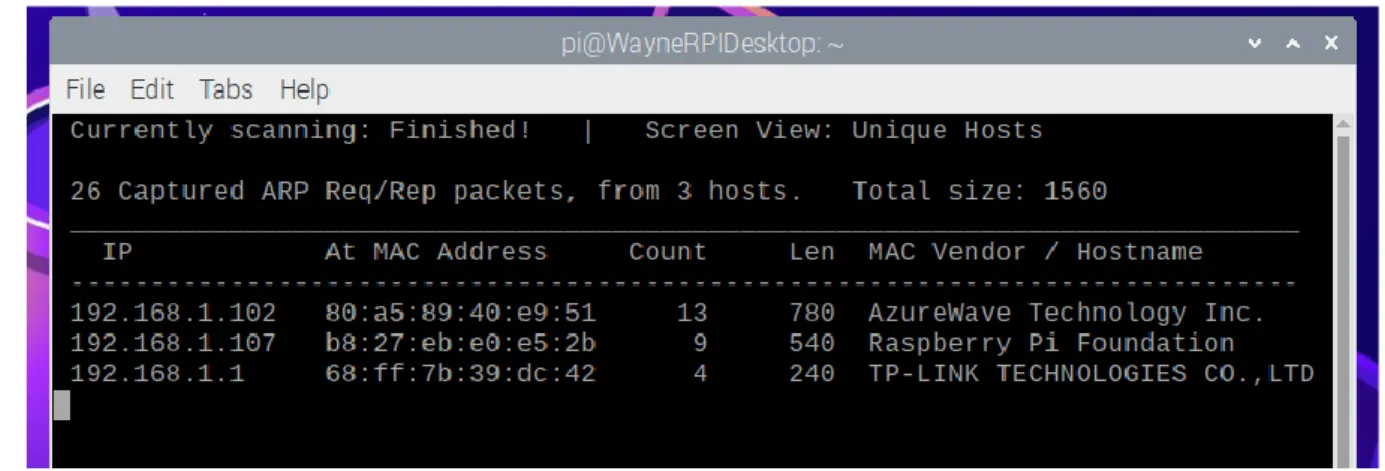
System Operation
Concluding Remark
System Evaluation And Discussion
- System Testing and Performance Metrics
- Testing Setup and Result
- Result of Raspberry Pi’s Detection Services
- Result of Temperature Monitoring Module
- Project Challenges
- Objectives Evaluation
- Concluding Remark
Based on the diagram as shown in Figure 6-2-2-1 is an electrical circuit design that would work with an Arduino board. Based on the diagram, the component highlighted in purple is the temperature sensor and the LEDs highlighted in blue would be used to display the ambient temperature status. If the temperature is between 24°C and 27°C, the green LED in the middle of the red and yellow LEDs will be triggered.
In this project, the Arduino was also used as the component to see if the light level around it is bright enough to indicate if the Raspberry Pi needs more light to clearly capture the images of the fish. Based on the design of the circuit board, Figure 6-2-3-1 showed the LDR light sensor and the green LED indicator that would be activated based on certain situation. One of the rooms as mentioned is a dark room and the other one is a bright room.
In addition, there is also a challenge during project development, and that is the Raspberry Pi's limited computing power. However, due to the design of the Raspberry Pi SBC, the hardware is not capable of that. In this chapter, several experiments have been conducted to evaluate the overall performance of the fish monitoring system.
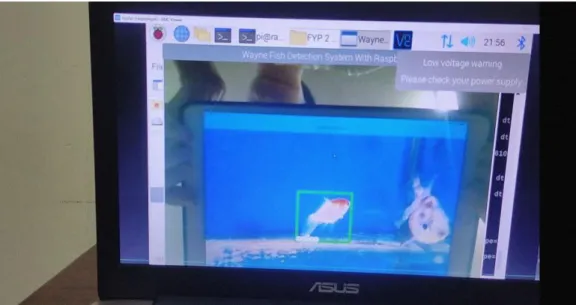
Conclusion And Recommendation
Conclusion
Recommendation
Due to that, the performance of the detection services is not efficient as the deep learning module is a CPU intensive process. To improve the speed of the detection system, it is suggested to use a better SBC such as the UDOO Bolt SBC that has a built-in AMD Ryzen processor. Aside from using a more powerful SBC, the Raspberry Pi's speed can still be increased by using a Google Coral USB accelerator.
Based on the reviews of the USB accelerator, it could improve the detection speed to more than double the original performance of the Raspberry Pi. Additionally, the Raspberry Pi configured in this project is designed to connect to the Internet via Ethernet for remote access purposes. For better mobility, it is still possible to enable the Raspberry Pi to connect to the Internet wirelessly.
In this project, the LM35 temperature sensor is not very suitable to be used to measure the temperature of the water in the aquaculture farm, as the component itself is not waterproof. 64 environment illuminance data to the Arduino to allow the microcontroller to turn on some brighter bulbs to provide light to the aquaculture farm. SJ, “Deep Learning for Inexpensice Image Classification of Wildlife on the Raspberry Pi,” in IEEE Xplore.
FINAL YEAR PROJECT WEEKLY REPORT
- WORK DONE -None
- WORK TO BE DONE
- PROBLEMS ENCOUNTERED -None
- SELF EVALUATION OF THE PROGRESS
- WORK DONE
- WORK TO BE DONE -Research about Arduino
- PROBLEMS ENCOUNTERED
- SELF EVALUATION OF THE PROGRESS -None
- WORK TO BE DONE -Report Writing
- WORK TO BE DONE -None
Title of Final Year Project Real Time Vision Based Fish Monitoring System Using Raspberry Pi. Mandatory if parameters of originality exceed the limits approved by UTAR). Parameters of originality required and limits approved by UTAR are as follows:. i) Overall similarity index is 20% and below, and. ii) Matches of individual sources listed must be less than 3% each, and (iii) Matching texts in continuous block must not exceed 8 words. Note: Parameters (i) – (ii) will exclude citations, bibliography and text matches that are less than 8 words.
Note Supervisor/candidate(s) are expected to provide a soft copy of the complete set of originality report to Faculty/Institute. Based on the above results, I hereby declare that I am satisfied with the originality of the Final Year Project Report submitted by my student(s) as mentioned above. Form title: Supervisor's comments on originality report generated by Turnitin for submission of final year project report (for undergraduate programs).
UNIVERSITI TUNKU ABDUL RAHMAN
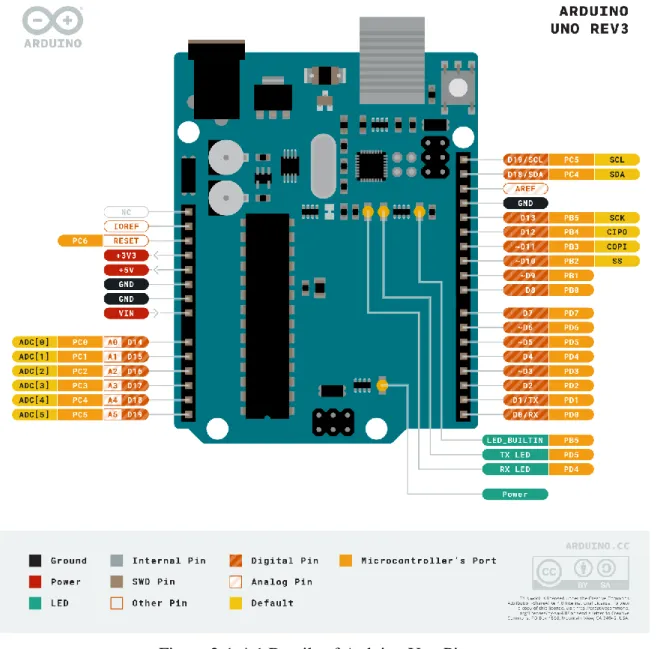
![Figure 2-2-2-1 Example of Images Extracted from UWA Dataset Videos Source : [18]](https://thumb-ap.123doks.com/thumbv2/azpdforg/10216718.0/32.892.184.708.369.640/figure-example-images-extracted-uwa-dataset-videos-source.webp)
![Figure 2-2-2-3 Example Result from Subsystems and the Combined Result Source : [18]](https://thumb-ap.123doks.com/thumbv2/azpdforg/10216718.0/34.892.123.782.234.446/figure-example-result-subsystems-combined-result-source.webp)
![Figure 2-2-3-1 Architecture of The Proposed System Source : [19]](https://thumb-ap.123doks.com/thumbv2/azpdforg/10216718.0/35.892.119.765.340.735/figure-architecture-proposed-source.webp)

![Table 2-2-4-3 Estimated Hardware Cost Source : [20]](https://thumb-ap.123doks.com/thumbv2/azpdforg/10216718.0/39.892.96.796.105.358/table-estimated-hardware-cost-source.webp)
